 Image search results - "geisha" Image search results - "geisha" |

April 8, 2006 at Ushigome-Tansu Kumin Hall in Kagurazaka, TokyoStarting at 4 pm, this was the third and last show of the day and all 400 seats were sold out.
The performance had two parts separated by a 20-min. intermission. Each part had several different dances.
|
|

PR poster for the Kamogawa Odori geisha dance held during May 1-24 in Pontocho.
|
|

"Hana no Kai" Dance by Kagurazaka geishaThe "Hana no Kai" geisha dance is held annually by geisha in Kagurazaka, one of Tokyo's major geisha districts. "Hana" means livley or gaudy. And "Kai" can mean gathering or party.
They held two shows on the same day. This was the second show starting at 3 pm on April 16, 2005. It lasted till about 4:45 pm.
|
|

Part 1 - Edo Scenes (江戸風情): 1. Fuji Murasaki (Purple Wisteria) 藤むらさきDancers: 小奴、千佳、由良子、舞子
|
|

Pontocho Kaburenjo theater, venue for Kamogawa Odori.
|
|

"Blue Ocean Waves" (青海波)They performed four numbers. This first one was called "Blue Ocean Waves" performed by five geisha.
|
|

1. Fuji Murasaki (Purple Wisteria)
|
|

Pontocho is a narrow alley and known as a geisha district.
|
|

Notice that the kimono design shows waves.
|
|

1. Fuji Murasaki (Purple Wisteria)
|
|

Dance program for 2005.
|
|
|

1. Fuji Murasaki (Purple Wisteria)
|
|

Barrels of sake next to the theater.
|
|

Rear view
|
|

1. Fuji Murasaki (Purple Wisteria)
|
|

A geisha/geiko and maiko head to the theater to see the Kamogawa Odori. Notice the different obi sash on the back.A maiko is an apprentice geisha. Her obi sah on the back is long, as well as her sleeves.
|
|

Shimada hairstyleStandard hairstyle for geisha. This a wig.
|
|

1. Fuji Murasaki (Purple Wisteria) by Kagurazaka geisha
|
|

Pontocho Kaburenjo theater
|
|

Music and singing accompanimentAll numbers was accompanied by live music and singing.
|
|

1. Fuji Murasaki (Purple Wisteria)
|
|

Geiko and maiko in front of Pontocho Kaburenjo theater
|
|
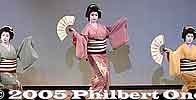
Eight Views of Tatsumi (巽八景)The second number was about the Tatsumi and Monzen-nakacho (Fukagawa) district in Koto Ward, Tokyo. The dance reflects the chic and bravado of the area (in the old days) which was one of Tokyo's gay quarters with geisha as well.
|
|

1. Fuji Murasaki (Purple Wisteria)
|
|

Entrance to Pontocho Kaburenjo theater. You can buy tickets for the day's performance.
|
|
|

1. Fuji Murasaki (Purple Wisteria)
|
|

Inside the theater, waiting for the start of the 168th Kamogawa Odori (in 2005) to start.
|
|
|

1. Fuji Murasaki (Purple Wisteria)
|
|

Part 1 Monogusa Soshi: Taro's Shack. Lazy Taro does nothing but compose poems all day in his shack. 物ぐさ草紙 太郎の小屋The first half is a musical play with a storyline.
|
|
|
|

1. Fuji Murasaki (Purple Wisteria)Dancer's name is Maiko 舞子
|
|

Taro's Shack
|
|

Her big round eyes makes her look like a real doll.
|
|

Unlike geisha dances in Kyoto which have elaborate backgrounds, the background here is quite plain, making us focus on the geisha which were enough eye candy. The background really didn't matter. The dances were very aesthetic and pleasing to the eyes and ears.
|
|

1. Fuji Murasaki (Purple Wisteria)
|
|
|
|

1. Fuji Murasaki (Purple Wisteria)
|
|

Magistrate's House
|
|
|

Edo Scenes: 2. Sumidagawa (Sumida River)Solo dancer: 眞由美 (Mayumi)
|
|
|
|

Maiko poses in front of the Naginata-boko float across the street in Kyoto
|
|
|

2. Sumidagawa (Sumida River)
|
|
|
|

A real crowd pleaser. Thanks for posing!
|
|

Closing curtain
|
|

Tekomai geisha. Their costume is colorful and partially masculine with trousers instead of skirts. Their right shoulder is "exposed" to show a peony flower (botan) design. They carry a red paper lantern imprinted with their names.
|
|

2. Sumidagawa (Sumida River)
|
|
|

IntermissionThis Ushigome-Tansu Kumin Hall can hold almost 400 people. Both shows were sold out. Tickets are sold about a month in advance. They sold out within 2 weeks. I was sitting in the middle of the hall (non-reserved seating). Tickets cost only 2,000 yen.
|
|

Tekomai geisha. They existed since the Edo Period. They served as side entertainment at festivals. They only sing traditional chant-like songs called kiyari. 手古舞
|
|

Edo Scenes: 3. Edo no Nigiwai (Liveliness of Edo) 江戸の賑わいDancers: 竜也、英子、万り
|
|

Taro overhears the Lord's daughter trying to compose a poem.
|
|

Chestnut Rice Cakes (栗餅)The third number was called "Chestnut Mochi." Mochi is rice cake. They pound sticky rice to make it. Performed by two geisha. The one in blue is a male role.
|
|

This troupe of 25 local women preserve a traditional art of Edo. They attend regular singing practice led by an elderly woman who was an authentic tekomai in her day.
|
|

3. Edo no Nigiwai (Liveliness of Edo)
|
|
|
|
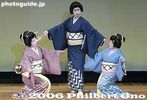
3. Edo no Nigiwai (Liveliness of Edo)
|
|

Taro helps her compose her poem.
|
|

Lively Colors of Kagurazaka(神楽坂華の彩)The final number, called Lively Colors of Kagurazaka (Kagurazaka Hana no Irodori) actually consisted of seven dances. This was the first one performed by three geisha. (ひと里)
|
|

3. Edo no Nigiwai (Liveliness of Edo)After this dance was a 20-min. intermission.
|
|

Taro has a scuffle with the daughter and breaks her koto instrument.
|
|

Kagurazaka geisha dance
|
|

Part 2 - 浴曲三味線草: 1. Kagurazakari 神楽ざかり
|
|

Mother scolds the daughter for the scuffle with Taro.
|
|

Kagurazaka geisha dance
|
|

1. Kagurazakari 神楽ざかり
|
|
|
|

1. Kagurazakari 神楽ざかり
|
|
|
|

引けや引け引け
|
|

1. Kagurazakari 神楽ざかり
|
|
|
|
|

Singers and musicians
|
|

It turns out that Taro was a grandson of the Emperor.
|
|

悋気しゃんすなSolo number performed by Maiko (her name). 舞子
|
|

Mt. Fuji and Mt. Asama(富士や浅間). Solo dance by a geisha named Mari(万り).
|
|

1. Kagurazakari 神楽ざかり
|
|
|

2. Hitozato ひと里
|
|

The Word Called Love (恋と云う字)
|
|

2. Hitozato ひと里
|
|

Taro gets to marry the lord's daughter.
|
|
|

3. 梅にも春 Ume ni mo HaruDancers: 千丸、史織
|
|
|
|
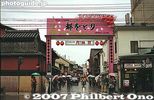
Entrance to the road leading to the Cherry Dance theater (Gion Kobu Kaburenjo) in the Gion district. The sign says "Miyako Odori."
|
|

Pagoda and maiko
|
|

3. 梅にも春 Ume nimo Haru
|
|
|
|

More signposts reading "Miyako Odori." "Miyako" means capital (Kyoto was once Japan's capital city), and "Odori" means dance.
|
|

3. 梅にも春 Ume nimo HaruOffering a drink of sake.
|
|

End of Part 1 with a happy ending.
|
|

After the dance, this geisha posed with us for a picture.
|
|

"Miyako Odori" sign post. Performed for over a century, the dance makes April a very special time in Kyoto. It helps to hone the dance and musical skills of the geiko and maiko who diligently practice for this annual dance.
|
|

4. Sakura Kazashite 桜かざしてDancers: 舞子、万り (Maiko and Mari)
|
|

Part 2: Passing of Spring in Kyoto, "Nanohanaya" (Rape blossoms) 菜の花やPart 2 of the program consists of dance numbers.
|
|

Finale
|
|

4. Sakura Kazashite 桜かざしてDancer 舞子 (Maiko)
|
|

"Nanohanaya" (Rape blossoms) 菜の花や
|
|

"Miyako Odori" poster in English.
|
|
|

"Miyako Odori" poster and paper lantern.
|
|

5. Otsu-e 大津絵眞由美 (Mayumi)
|
|

"Nanohanaya"
|
|
|
|
|

5. Otsu-e 大津絵眞由美
|
|

"Nanohanaya"
|
|

PR posters and paper lanterns for the Miyako Odori are everywhere.
|
|

6. Hahha Kudoki ハッハくどき
|
|

"Nanohanaya" (Rape blossoms) 菜の花や
|
|
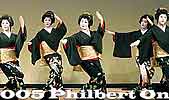
Finale
|
|

Ichiriki, a famous geisha tea house.
|
|
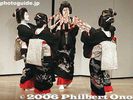
6. Hahha Kudoki ハッハくどき
|
|

"Nanohanaya" (Rape blossoms). They dance like they were melting into the sea of flowers. 菜の花や
|
|

Praying at BishamonBishamon is a Buddhist temple in Kagurazaka where the geisha go to worship. The song included a reference to this temple.
|
|

Maiko and geisha can often be seen in Gion.
|
|

6. Hahha Kudoki ハッハくどき
|
|

"Nanohanaya" (Rape blossoms) 菜の花や
|
|

Praying at Bishamon
|
|

Gate to Kobu Kaburenjo Theater. Four shows daily in April, lasting about 1 hour (too short). Ticket prices range from 1900 yen to 4300 yen.
|
|
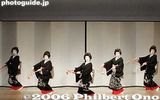
6. Hahha Kudoki ハッハくどき
|
|

"Irises" are in full bloom. 菖蒲
|
|

FinaleEveryone performed in the finale.
|
|

Gate to Kobu Kaburenjo Theater. You can make ticket reservations by phone, or go directly to the theater ticket office and buy tickets.
|
|

6. Hahha Kudoki ハッハくどき
|
|

"Irises" 菖蒲
|
|
|

Gion Kobu Kaburenjo Theater. Ticket office is on the right. Best to buy tickets at least a few days in advance.
|
|

6. Hahha Kudoki ハッハくどき
|
|

"Irises" 菖蒲 She rises from beneath the stage.
|
|
|

7. Sawagi さわぎThe finale where all the geisha appear on stage.
|
|

"Irises" She holds an iris flower. She just took a bath with iris leaves. 菖蒲
|
|

Towel throwingDuring the finale, the geisha started throwing hand towels to the audience.
|
|

7. Sawagi さわぎ
|
|

"Irises" 菖蒲
|
|

Towel throwingThere were women in the middle the hall also throwing towels to people sitting further back.
|
|

7. Sawagi さわぎ
|
|

Comical play called "Kyogen Furyu" 狂言風流
|
|
|

7. Sawagi さわぎ
|
|

"Kyogen Furyu" 狂言風流
|
|

A bow of thanks
|
|

Tossing free hand towels to the audience, a real crowd pleaser...They do this every year. Most people sitting in the front can catch one.
|
|

"Kyogen Furyu" 狂言風流, comical play featuring a rabbit and monkey who enjoy the longer daylight in spring.狂言風流
|
|

"April Rain" 卯月の雨
|
|

"April Rain" 卯月の雨
|
|

Closing wordsThe women standing in the back are the okami-san (proprietress) of high-class Japanese-style restaurants in Kagurazaka where the geisha are hired to perform at private geisha parties.
|
|
|
|

Finale: "Hana Utage" (Flower Banquet) 花うたげ
|
|
|

Arigato
|
|

Finale: "Hana Utage" (Flower Banquet). Spring yields to early summer. 花うたげ
|
|

Hand clappingThis is called sanbon-jime, a series of hand clapping to mark the end of a successful meeting.
|
|

Facing the right in thanks...
|
|

Finale: "Hana Utage" (Flower Banquet) 花うたげ
|
|

Hall entrance and sign
|
|

Tekomai geisha from Tomioka Hachimangu Shrine walk toward the stage.
|
|

(Applause)
|
|

Finale: "Hana Utage" (Flower Banquet) 花うたげ
|
|

Geisha catching a taxi homePhoto by Kevin Mihaly.
|
|

They perform in mid-Oct. on the same day and place as Kiba Kakunori log rolling.
|
|

With okami-san
|
|

Geisha on palanquin.
|
|

Finale: "Hana Utage" (Flower Banquet) 花うたげ
|
|

Their right shoulder is "exposed" to show a peony flower design. Also see the video at YouTube.
|
|

The procession includes geisha and other celebrities.
|
|

Finale: "Hana Utage" (Flower Banquet) 花うたげ
|
|

They carry a red paper lantern imprinted with their names and use their right hand to drag along a metal wand.
|
|
|
|
|
|
|
|

Tomioka Hachiman Tekomai geisha perform at Kiba Park.
|
|

Finale: "Hana Utage" (Flower Banquet) 花うたげ
|
|
|
|

Finale: "Hana Utage" (Flower Banquet) 花うたげ
|
|

They only chant, no dancing.
|
|

Finale: Throwing hand towels
|
|

Tomioka Hachiman tekomai geisha
|
|

Finale: "Hana Utage" (Flower Banquet) 花うたげ
|
|

Tomioka Hachiman tekomai geisha
|
|

Finale: "Hana Utage" (Flower Banquet) 花うたげ
|
|

Tekomai geisha cross Eitai-bashi Bridge to enter Koto Ward along Eitai-dori.
|
|
|
|
|
|
|
|
|

Finale: "Hana Utage" (Flower Banquet) 花うたげThis is a maiko.
|
|

手古舞
|
|
|
|

Finale: "Hana Utage" (Flower Banquet) 花うたげ
|
|

Tekomai geisha at Eitai-bashi
|
|
|

End of show, see you next year in May!
|
|

Tekomai geisha at Eitaibashi
|
|

During the finale, the tekomai and Kiba Kiyari singers sing together.
|
|

Pontocho Kaburenjo theater as seen from Kamogawa River.
|
|

Tekomai geisha
|
|

Geisha
|
|

Kamogawa River next to the theater.
|
|

They sing and chant while walking slowly.
|
|
|
|

They have flower hats, but I've never seen them wear it on their heads.
|
|

Tekomai geisha on Eitai-dori road, entering Koto Ward
|
|

They do not get water splashed.
|
|

Ebisu on a palanquin.
|
|

Geisha
|
|

Fukagawa Tekomai geisha make their entrance. 深川手古舞
|
|

Geisha on a palanquin
|
|
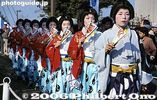
The Fukagawa Tekomai geisha make their way to the stage.
|
|

Geisha on a palanquin, Toka Ebisu, Imamiya Ebisu Shrine, Osaka
|
|

They chant without instruments.
|
|
|
|
|
|
|

Each carry a lantern bearing their name.
|
|

They always carry a flower hat, but I've never seen them wear it.
|
|
|
|

The stage in Kiba Park and spectators.
|
|
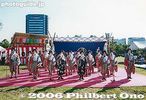
Fukagawa Tekomai Geisha performing at Kiba Park, Koto Ward, Tokyo.
|
|

Geisha and Maiko in KyotoThis is in Pontocho, one of Kyoto's geisha districts. The woman on the left is a geisha (called "geiko" in Kyoto), the woman in the middle is a helper, and the woman on the right is a maiko or apprentice geisha. They are on their way to see the Kamogawa Odori dance performed by the Pontocho geisha in May.
|
|

The cherry dance consists of several acts each with a different dance or play.
|
|
|

A hanamichi is also on the left side of the theater.
|
|
|

We were right near the hanamichi where the geisha performed.
|
|
|

Note that taking pictures and videos are not allowed.
|
|
|
|
|
|
|
|
| 826 files on 4 page(s) |
1 |
 |
|